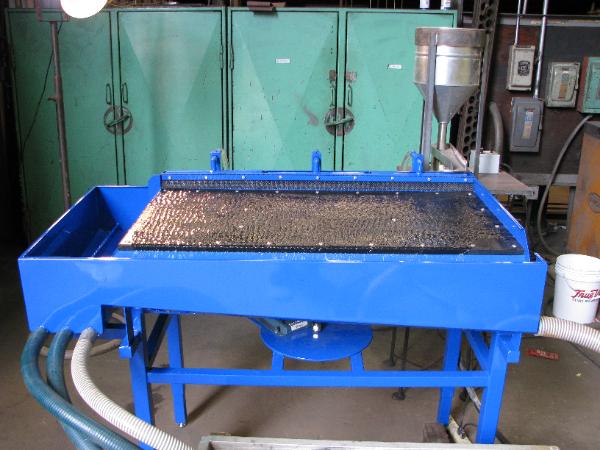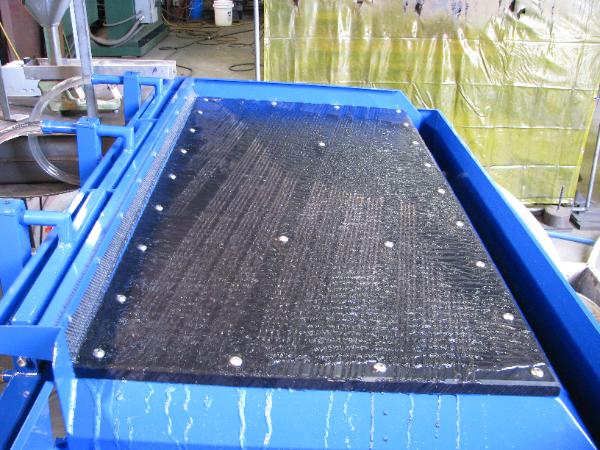Mining Equipment...
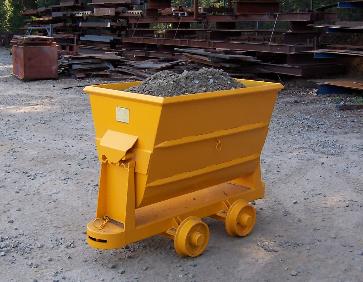
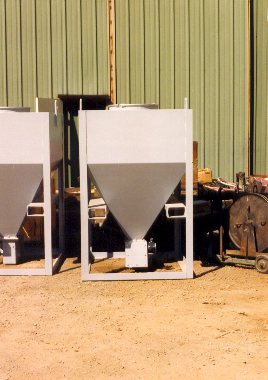
| 1 Ton Ore Cars |
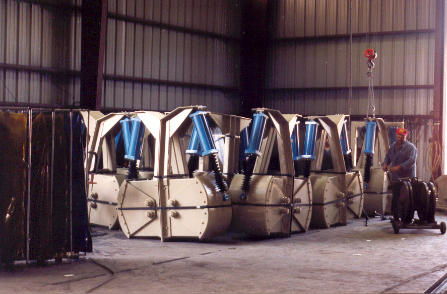
| Hoppers |
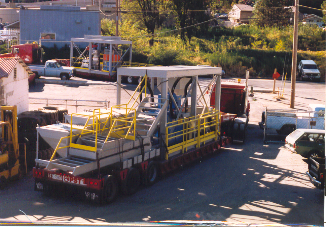
Clam Shell Gates
Slag Recycle Plant
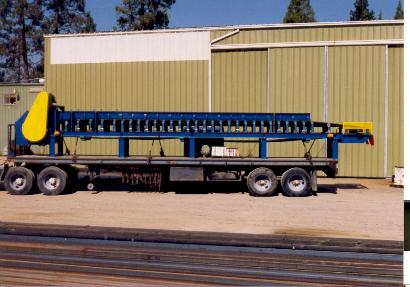
| For Quotes Call Jason White 530-265-4591 or |
Conveyors

Standard Models Available:
Model Description Water(GPM) Tons/Hr
2040FT 2'x4' Finish Table 3 0.1
4080FT 4'x8' Finish Table 20 0.8
4080 4'x8' Roughing Table 20 2
Other Sizes can be custom manufactured. Call for details.
Options:
Riffles
Tapered UHMW - Riffles are machined into a UHMW plastic top, tapering from 1/8" to 1/16" Depth.
This assists in cleaning the concentrate, but reduces capacity. It is typically used on finish tables
Straight UHMW - Riffles are machined into a UHMW plastic top at 1/8" Depth. This riffle configuration
should be used where a large amount of concentrate is generated.
Extruded Aluminum - Riffles are formed in an extruded aluminum plank. Different extrusions are
available depending on your feed size. These riffles are typically used in a roughing situation.
Troughing
Troughs can be standard, or custom made to fit your particular circumstance.
Power
Tables come standard with a variable speed motor wired for 110 or 220, 60 cycle. Other voltages or
cycles available on request.
Feed
A vibratory feeder with hopper can be furnished on request. You will find that maintaining a steady
rate of feed is critical to proper performance. These feeders make maintaining a steady feed
rate simple.
Theory of Concentration
Two primary principles are used in table concentration:
1.) Stratification. If a bed of material that is approximately equally sized, but which differs in density is subject
to repeated motion, that material will classify itself. The more dense particles will come to occupy the bottom of
the bed, with decreasingly dense particles occupying successive layers.
2.) Skin Effect. Close to the surface, the force that a flow of water will exert on a particle sitting on a flat
surface will vary with the square of the distance above the surface. This means that particles close to the
surface are relatively protected from the force imparted by a flow of water.
How, then, does a table concentrator use these effects to separate material by density? This is accomplished
by the action of the table. In the Wilfrey design, which was first patented in 1895 and is still in use today, the
table is mechanically moved back and forth along its long axis by a cam arrangement. The cam is arranged
such that the forward stroke is slower than the backward stroke. This tends to move the material down the
long axis of the table because the slow forward motion carries the mineral particles with the stroke, and the
fast backward stroke jerks the table out from underneath the particles. Other tables use an unbiased stroke
and rely on either a rubber or spring bumper on one end of the stroke, or simply incline the table toward the
concentrate discharge, thus using gravity to create a bias in the stroke. Because particles closest to the table
are most affected by the action of the table, they tend to be moved farther along the table in the direction of
the stroke. Due to stratification (also provided by the table action), the particles closest to the table surface
tend to be those with greatest density. The table settings (feed rate, slope, stroke length, stroke frequency,
wash water) are then modified so that the desired particles can make it to the end of the table and discharge
into the concentrate trough before they are washed down the side of the table to the tailings trough. Riffles
are typically added to the table surface in order to increase the carrying capacity of the table, and to protect
small dense particles from the scouring action of larger less dense particles as they are washed down the
table.
How the UHF table improves on this process
1.) The action of the table is not provided by a mechanical motion, but by high frequency vibration. This
allows a much higher frequency than that obtainable by mechanical means. A typical frequency for a Wilfrey
style table is 250 strokes per minute. The UHF concentrator is making up to 1750, or 7 times the number of
impulses per minute. This faster speed allows for a more efficient and rapid stratification of the bed of
minerals. The sooner a denser particle comes into contact with the table surface, the sooner it is moved by
the table action toward the concentrate end, and the less chance there is for it to be carried away with the
tailings.
2.) Because the motion is provided by a vibrator instead of a mechanical motion, the direction of the
motion relative to the table can be changed. Typically it is set somewhere in between straight down the table
(as in the Wilfrey design), which gives greatest capacity at the expense of lesser separation, and 90 degrees
off that setting, which gives minimum capacity, but best separation. By setting the direction of vibration up
from straight down the table, gold and other heavy particles can be made to move up the incline of the table
against the current of water as they proceed toward the concentrate end. In many cases this allows for the
generation of a gold concentrate so pure that it can be directly melted.
3.) The UHF table is designed to give the operator total control of the table action. In addition to the
adjustments available on other tables, the vibrator speed, direction, and force, and table balance can be
changed. These additional controls can be the difference between being able to treat an ore by gravity
means, and having to resort to more expensive chemical methods.
4.) The UHF table uses specially designed riffles which are back cut to provide a low pressure area of
safety for fine mineral particles. This is simply the application of the principles of riffle design that have been
demonstrated as being effective in modern sluice boxes. Strangely, most tables still use a straight cut riffle.
The riffles on the UHF table occur in a deliberately irregular pattern, as well as having areas of the table
between them that are free of riffles. This prevents the occurrence of standing waves on the table that can
carry mineral particles down the table. This is similar to the reason that band saw blades have an intermittent
pattern of teeth. If they were equally spaced, a harmonic vibration could result, damaging the material, the
blade, or both. Riffles on the UHF table can be tapered or non-tapered. Typically a tapered riffle is preferred,
as it tends to give a cleaner product, but a non-tapered riffle will increase capacity where a large amount of
concentrate is created, and is recommended for roughing tables.
Model Description Water(GPM) Tons/Hr
2040FT 2'x4' Finish Table 3 0.1
4080FT 4'x8' Finish Table 20 0.8
4080 4'x8' Roughing Table 20 2
Other Sizes can be custom manufactured. Call for details.
Options:
Riffles
Tapered UHMW - Riffles are machined into a UHMW plastic top, tapering from 1/8" to 1/16" Depth.
This assists in cleaning the concentrate, but reduces capacity. It is typically used on finish tables
Straight UHMW - Riffles are machined into a UHMW plastic top at 1/8" Depth. This riffle configuration
should be used where a large amount of concentrate is generated.
Extruded Aluminum - Riffles are formed in an extruded aluminum plank. Different extrusions are
available depending on your feed size. These riffles are typically used in a roughing situation.
Troughing
Troughs can be standard, or custom made to fit your particular circumstance.
Power
Tables come standard with a variable speed motor wired for 110 or 220, 60 cycle. Other voltages or
cycles available on request.
Feed
A vibratory feeder with hopper can be furnished on request. You will find that maintaining a steady
rate of feed is critical to proper performance. These feeders make maintaining a steady feed
rate simple.
Theory of Concentration
Two primary principles are used in table concentration:
1.) Stratification. If a bed of material that is approximately equally sized, but which differs in density is subject
to repeated motion, that material will classify itself. The more dense particles will come to occupy the bottom of
the bed, with decreasingly dense particles occupying successive layers.
2.) Skin Effect. Close to the surface, the force that a flow of water will exert on a particle sitting on a flat
surface will vary with the square of the distance above the surface. This means that particles close to the
surface are relatively protected from the force imparted by a flow of water.
How, then, does a table concentrator use these effects to separate material by density? This is accomplished
by the action of the table. In the Wilfrey design, which was first patented in 1895 and is still in use today, the
table is mechanically moved back and forth along its long axis by a cam arrangement. The cam is arranged
such that the forward stroke is slower than the backward stroke. This tends to move the material down the
long axis of the table because the slow forward motion carries the mineral particles with the stroke, and the
fast backward stroke jerks the table out from underneath the particles. Other tables use an unbiased stroke
and rely on either a rubber or spring bumper on one end of the stroke, or simply incline the table toward the
concentrate discharge, thus using gravity to create a bias in the stroke. Because particles closest to the table
are most affected by the action of the table, they tend to be moved farther along the table in the direction of
the stroke. Due to stratification (also provided by the table action), the particles closest to the table surface
tend to be those with greatest density. The table settings (feed rate, slope, stroke length, stroke frequency,
wash water) are then modified so that the desired particles can make it to the end of the table and discharge
into the concentrate trough before they are washed down the side of the table to the tailings trough. Riffles
are typically added to the table surface in order to increase the carrying capacity of the table, and to protect
small dense particles from the scouring action of larger less dense particles as they are washed down the
table.
How the UHF table improves on this process
1.) The action of the table is not provided by a mechanical motion, but by high frequency vibration. This
allows a much higher frequency than that obtainable by mechanical means. A typical frequency for a Wilfrey
style table is 250 strokes per minute. The UHF concentrator is making up to 1750, or 7 times the number of
impulses per minute. This faster speed allows for a more efficient and rapid stratification of the bed of
minerals. The sooner a denser particle comes into contact with the table surface, the sooner it is moved by
the table action toward the concentrate end, and the less chance there is for it to be carried away with the
tailings.
2.) Because the motion is provided by a vibrator instead of a mechanical motion, the direction of the
motion relative to the table can be changed. Typically it is set somewhere in between straight down the table
(as in the Wilfrey design), which gives greatest capacity at the expense of lesser separation, and 90 degrees
off that setting, which gives minimum capacity, but best separation. By setting the direction of vibration up
from straight down the table, gold and other heavy particles can be made to move up the incline of the table
against the current of water as they proceed toward the concentrate end. In many cases this allows for the
generation of a gold concentrate so pure that it can be directly melted.
3.) The UHF table is designed to give the operator total control of the table action. In addition to the
adjustments available on other tables, the vibrator speed, direction, and force, and table balance can be
changed. These additional controls can be the difference between being able to treat an ore by gravity
means, and having to resort to more expensive chemical methods.
4.) The UHF table uses specially designed riffles which are back cut to provide a low pressure area of
safety for fine mineral particles. This is simply the application of the principles of riffle design that have been
demonstrated as being effective in modern sluice boxes. Strangely, most tables still use a straight cut riffle.
The riffles on the UHF table occur in a deliberately irregular pattern, as well as having areas of the table
between them that are free of riffles. This prevents the occurrence of standing waves on the table that can
carry mineral particles down the table. This is similar to the reason that band saw blades have an intermittent
pattern of teeth. If they were equally spaced, a harmonic vibration could result, damaging the material, the
blade, or both. Riffles on the UHF table can be tapered or non-tapered. Typically a tapered riffle is preferred,
as it tends to give a cleaner product, but a non-tapered riffle will increase capacity where a large amount of
concentrate is created, and is recommended for roughing tables.
